To Cook Without Folding
My month cooking in Paris—and what happened when I brought matriarchal fire to the city’s trendiest arrondissement + brik recipe
Marahba, hello!
Welcome to Kalām—Arabic for “words and conversation”—a publication for anyone hungry to explore Tunisia through its food, art, and culture. I'm Boutheina Ben Salem, a French-Tunisian cook, curator, and founder of the BabéldeB supper club.
Each month, I’ll bring you a table of tastes & tales: recipes you’ll want to cook for a lifetime, cultural dispatches that test what you think you know about North Africa, and curated finds.
For now, Kalām is free, like all the best conversations should be.
I’m not sure why it took me this long to write about my month in Paris—cooking, wandering, living through the slow churn of winter. Maybe I overthink things. Maybe I needed time to let it all settle. It was, after all, the first time I’d properly lived in France since I left over twelve years ago. Twelve. Seeing it written like that feels... abyssal.
My relationship with France is complicated. It is mine, as much as Tunisia is—but unlike Tunisia, France insists on a certain kind of belonging. One that demands you be French, while never letting you forget you’re not.
A sentence like that could keep a therapist in business for years. I’d rather save the fees and go through a baptism by fire—with Tunisian food as my therapist.
And that’s exactly what I did.
I landed in Paris on a grey, rain-slick January afternoon—and whoever said Paris was romantic in the rain was definitely American. My bags were heavy with homemade spices, sun-trapped ingredients, and a suitcase full of prejudices about Parisians.
I married one, mind you. But he’s hot, sophisticated, and he worships me—as he should.
Still, let’s put McSteamy on the back burner for now and rewind a few months, to the lead-up before my Parisian residency began.
I knew I was stepping into murky waters.
You see, if you’re a Western chef invited for a residency in Paris, you plan a menu, cook your best, and voilà—job done. But when you're a chef with an Arab background, focused on Tunisian matriarchal cuisine, and you're invited to cook at Café Singuliers—an achingly trendy spot in the 11th arrondissement, no less—that comes with a different weight entirely.
Because it’s not just you cooking. It’s the entire cuisine—and probably the entire country—you’re suddenly representing.
I knew I’d have to dismantle a few deeply-rooted misconceptions. And the biggest of them all—the one that really tested my level-headedness—was couscous.
I’ve written about this before, but it bears repeating: some French ideas about couscous have the stubbornness of an old myth. They think they know couscous. And let’s be honest—telling the French they don’t know something about food? That’s its own form of heresy.
Here’s the thing: French diners tend to be most familiar with the way couscous is eaten in Moroccan or Algerian households—where the grain and the broth are served separately, with sauce ladled on at the table.
So anytime I serve couscous to a French crowd—even in Marseille—I know what’s coming. Like clockwork, one minute after the dish leaves the pass, front of house returns with the same note: Chef, table xyz is asking—where is the sauce?
Well. The sauce is already making passionate love to the couscous, people.
In Tunisia, we mix the sauce into the grain. It’s called nsagou, and we even have a saying: khallih yéchreb—‘let it drink.’ Let the couscous drink up every drop of flavour before it ever reaches the plate. I mean—the couscous is red. It’s drenched. It’s alive.
Then came the dilemma of the menu.
I wanted to bring the unexpected. To walk in, hands-on-heart, and sing my culture unapologetically. I wanted to plant the flag of Tunisian cuisine populaire right in the middle of a space that didn’t expect it—and maybe didn’t even know it needed it.
And when I say populaire, I don’t mean street food—though TikTok seem to think that’s all Tunisian cuisine has to offer. I mean dishes rooted in the social fabric. Recipes that have lived in the hands of millions—rich and poor, coastal and inland, passed through generations not as trends but as truths.
These are the foods shaped by working-class kitchens, by matriarchal logic, by a deep sense of season and necessity. They are the heartbeat of homes, the taste of reunion, of repair.
And they live in me—in the deepest, most stubborn part of me that will always and forever beat to the rhythm of Tunisian food.
And that’s how lablabi and drô became the unexpected stars of the menu. The dishes people came back for. The ones they held up as their favourites—bold, humble, unforgettable.
Let me tell you, I fought for lablabi. More than one person thought it had no place in a ‘fancy’ restaurant. Too street, too poor, too… something.
Now, allow me a brief dogma break—just a little one: never carve yourself into someone else’s idea of refinement. If it turns out to be a mistake, own it. Move on. But do not fold before the fire even gets lit.
Lablabi is a working-class dish made from the simplest ingredients and designed—brilliantly—to use up stale bread. At its core: chickpeas simmered in garlicky, cumin-laced broth, ladled over torn bread. Then a soft egg, harissa, tuna, capers, and a drizzle of olive oil. It’s meant to be mixed into a messy, sensual whole.
The version I served was lighter, with more broth—you have to leave room for the rest of the menu, right? Can’t have people full on the first course. What kind of businesswoman would I be?
And still, even after all the fight and prep and risk—what surprised me most wasn’t that people enjoyed the humble food. It was how deeply they understood it.
What I didn’t expect was how seen I’d feel. The way customers embraced lablabi and drô, the way they welcomed and honoured those dishes—it was deeply moving.
That residency in Paris marked me more than any other.
It shattered my own prejudices about Parisians—many of which were shaped by years of hearing McSteamy’s complaints about his own people. But what I found was something else entirely.
I felt truly welcomed. Tunisian food wasn’t just appreciated—it was met with real curiosity and care. Night after night, I had a dining room full of thoughtful people who didn’t just eat—they asked. About the history, the ingredients, the rituals behind each dish. They wanted more of Tunisia.
That curiosity lit something in me—but also made me confront a quiet conflict I’d been carrying for a while.
After service, I’d sit on the small bench outside the café, sipping a grogue Rauwanne thoughtfully made me one night when I looked like shit. It was freezing—some nights dipped to minus five—but I didn’t mind. My hands still smelled of garlic, my ears still rang with the clatter of plates and conversation. That’s where the real processing happened—in the quiet, with the steam still rising off me.
I’ve never rioted for the traditional restaurant model. The whole setup always felt like it risked disconnecting me from the people I cook for. I’ve told myself I’m not into performative cooking—and I believe that. Or at least, I want to believe that.
Still, I’d be lying if I said I never spiralled into the comparison trap—the relentless Instagram-perfect plates, the slick food displays that start to feel more like theatre than nourishment. I’ve caught myself drifting. Drifting from what actually drives me. From what brings me joy.
Cooking, for me, only makes sense under a few conditions:
I cook for people. I almost never cook for myself—I eat like crap when I’m alone.
I get to share the stories behind the ingredients. The people who grow them, ferment them, grind them, pass them down.
There’s a table, an art to lingering at the table. A sobremesa, as the Spanish say. Une belle tablée in French. In Tunisia, we call it lama—a joyful gathering around food.
There’s no room for performative cooking in that picture. And yet, I’ve often doubted myself. Obsessing over my ‘style.’ Wondering where I fit, if I’m too much or not enough, if my cooking is serious enough for the world I’m in.
The funny thing is, cooking has taught me far more about who I am as a person than who I am as a cook. It’s a mirror. Sometimes soft, sometimes brutal. Always honest.
And maybe that’s what this residency gave me in the end—not just clarity, but a reminder that food, like language, doesn’t need permission to belong.
It just needs a table and the right crowd.
From the kitchen: Brik à l’oeuf recipe
Serves 4
Ingredients:
4 brik pastry sheets*
300g potatoes (2 medium-small)
4 tbsp chopped parsley
2 tbsp finely chopped spring onions (can substitute with yellow onions)
1 tbsp capers
1 can of good-quality tuna
Harissa, to taste
Grated Emmental cheese, to taste
2 tbsp lemon juice
¼ tsp turmeric
Salt
Pepper
Oil for frying
Preparation:
1. Add turmeric and salt to water, then peel and boil the potatoes until cooked.
2. Coarsely mash the potatoes with a fork and mix in the parsley, spring onions, black pepper, lemon juice and harissa.
3. Heat oil in a frying pan large enough to hold the brik. The oil should be hot but not too high, to avoid burning the pastry while keeping the yolk inside runny.
4. Place a brik pastry sheet on a plate. Spoon about 1 heaped tablespoon of the potato mixture into the center of the pastry, shaping it into a circle large enough to hold an egg. Tip: create raised edges with the filling to keep the egg white from spilling.

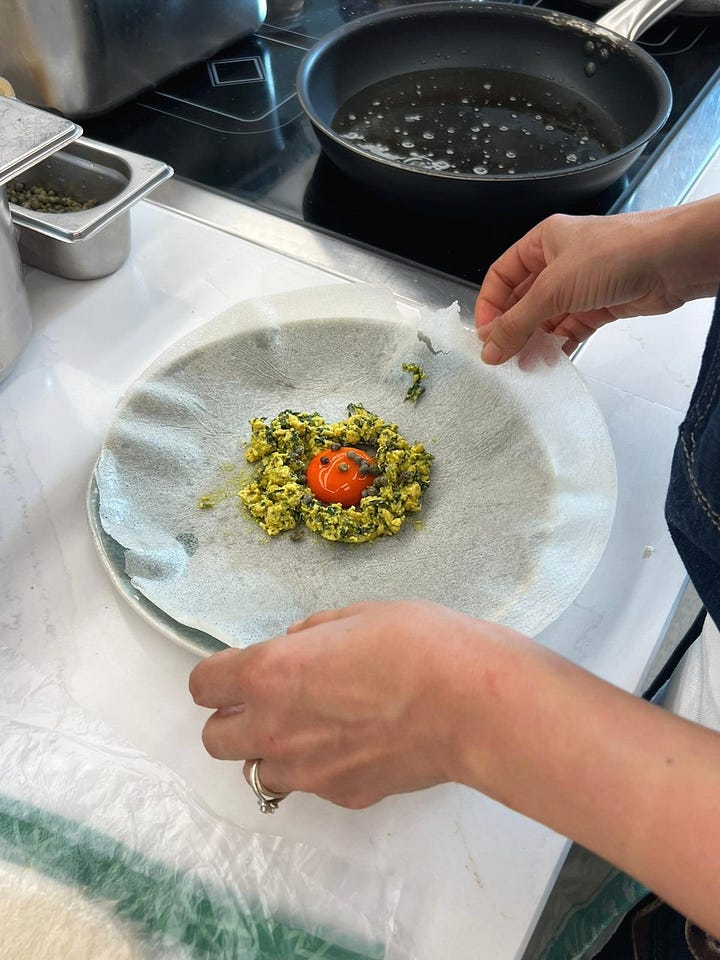
5. Add tuna on top of the filling, followed by some grated cheese and a few capers.
6. Crack an egg into the middle of the filling.
7. Test the oil temperature with a small piece of pastry— it should fry instantly but not brown too quickly.
8. Bring the plate closer to the pan. Fold one side of the brik pastry over the other to form a half-moon shape. Gently slide it off the plate and into the pan. The edges will seal upon contact with the hot oil. Use a wooden spoon to press down on the edges to ensure they are well sealed.
9. Fry the brik for 3 to 4 minutes on each side, depending on the size of the egg. The pastry should be crisp, and the yolk should remain runny. However, you can cook it longer if you prefer a firmer yolk.
10. Remove the brik and drain it on paper towels before transferring to a plate. Serve with a wedge of lemon, squeezing it over the brik just before eating.
The more you practice, the better you'll become at mastering the art of brik. Don’t be discouraged—keep going!
*Note: Brik pastry is a thin, crispy dough found in North African grocery stores (in London: Golborne Road, Blackstock road, Edgware road and Old Kent road).
If unavailable, you can substitute it with filo pastry. However, filo is more delicate and thinner than brik, so layer three sheets of filo together, sealing the edges before placing it into the frying pan.






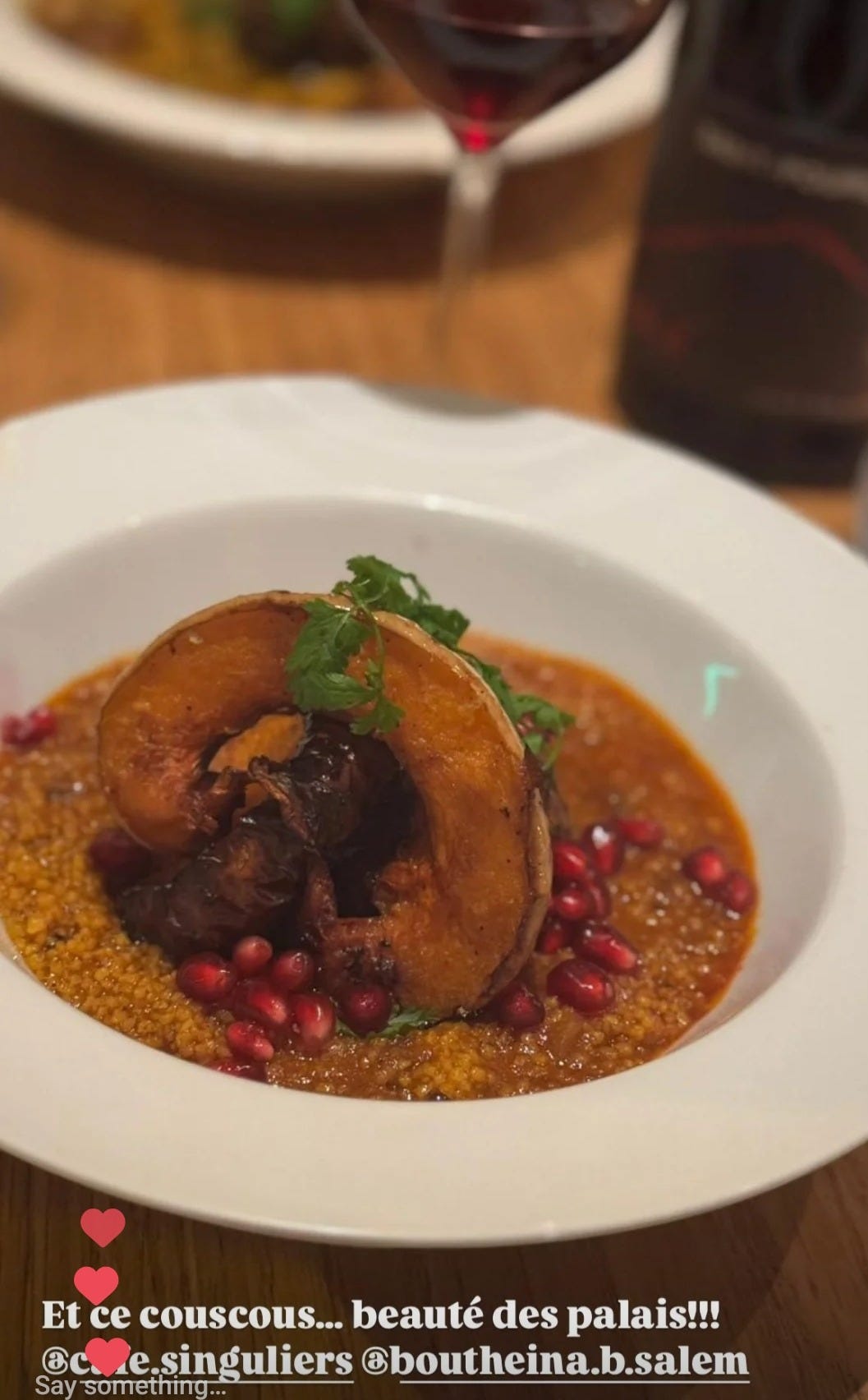
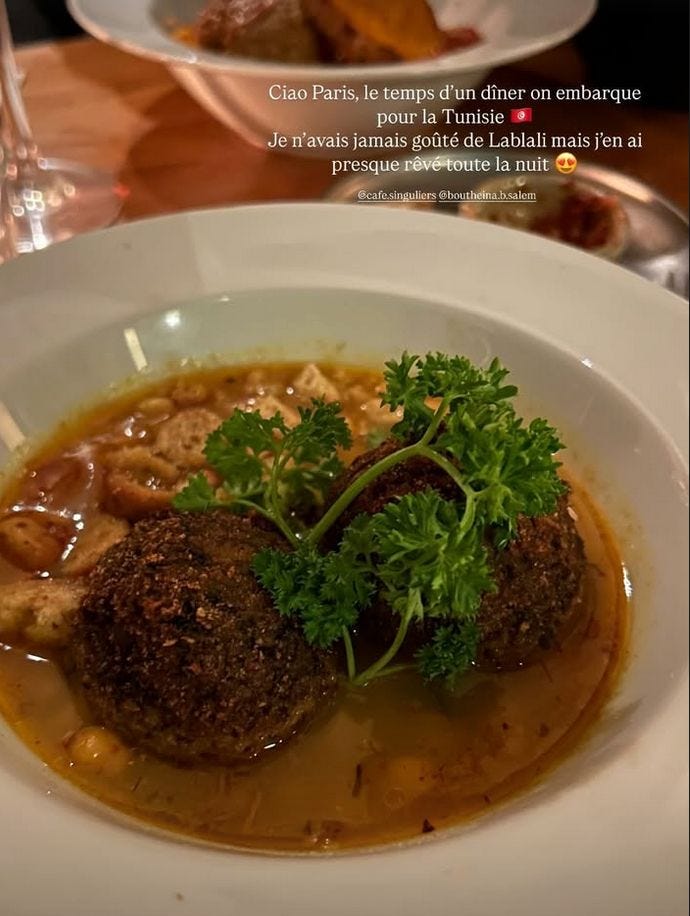
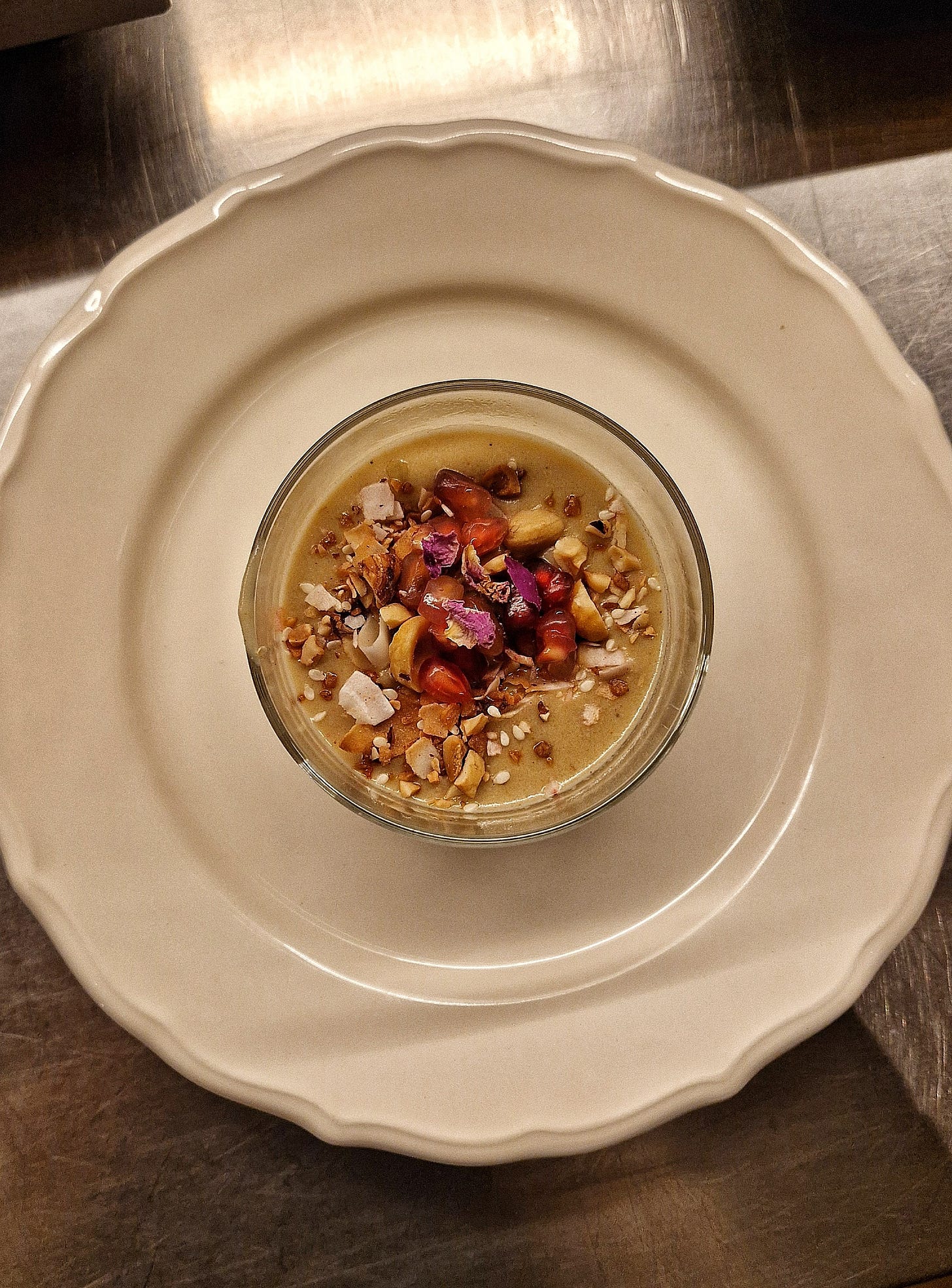

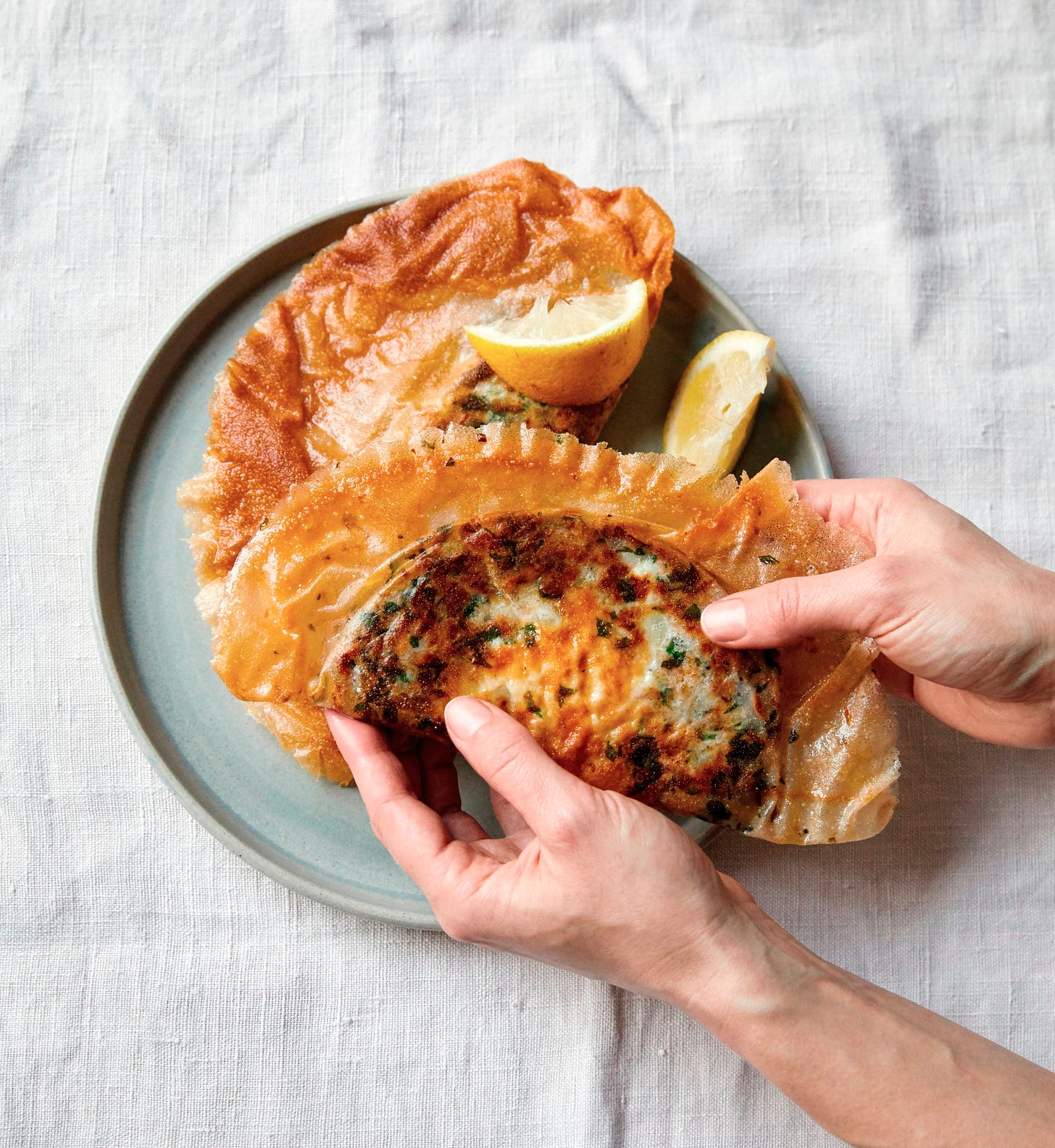
I loved the taste of all the food you made that night in Paris. And it was so funny realizing we both had the same harissa photo on our phones! 🫶🏼
Love reading you surprised the Parisian with your cuisine and of course they loved it. Who wouldn’t?! I wish I were there. Bravo. x